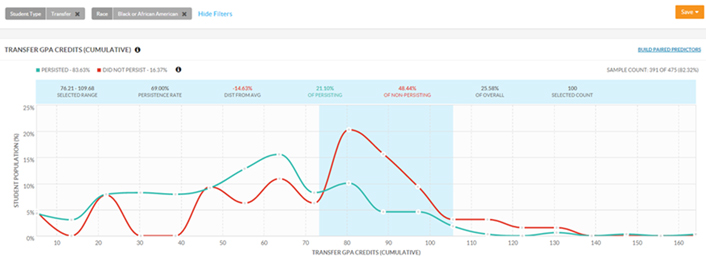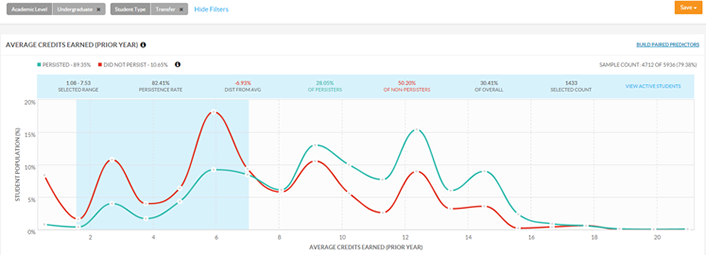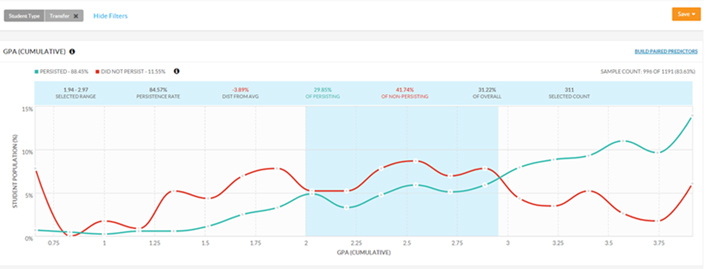Key Takeaways
- The competency-based program at Texas A&M University–Commerce has begun to analyze enrollment data to better understand their transfer student population and make predictions regarding future students.
- Transfer students entered the CBE program with an average 87 credits and graduated at rates that broke historically negative persistence patterns traditionally affecting part of the transfer student population.
- Adult learners outpace traditional-age students in pursuing degrees, and enrollment trends strongly suggest that post-traditional students will determine whether colleges reach enrollment targets and fulfill future workforce demands.
Prediction is very difficult, especially if it's about the future.1
—Neils Bohr
"Why a College Degree May Not Be Worth It." "Is college worth it? Goldman Sachs says maybe not." "Help wanted: College degree not needed." These alarmist headlines fed recent ubiquitous debates concerning the value of higher education, casting doubt on its return on investment, particularly compared to its high costs and rising student debt. Skeptics notwithstanding, most research supports the benefits of a college degree for professional advancement, social mobility, and higher earning potential; increased contributions to society; and overall personal wellbeing.2 However, in the state of Texas alone over three million adults have amassed college credits but no degree. In some cases, the amount of college credit amassed, with no credential, is substantial. The competency-based education (CBE) program here at Texas A&M University–Commerce (TAMU-C) serves these students intentionally, by design. Here we highlight some of our initial efforts to dig into enrollment data to better understand this transfer student population and make predictions regarding future students. Initial analysis of this data indicates that our CBE program is breaking negative persistence and completion patterns related to adult transfer students at our institution — and we are making progress (albeit nascent) toward fulfilling the original goals of the program. Predictive analytics provide a solid foundation to build on that progress.
The CBE Organizational Leadership Degree
TAMU-C's competency-based BAAS in Organizational Leadership is a relatively young program, created in direct response to the then-governor's 2011 challenge to all Texas public institutions of higher education to create a $10,000 bachelor's degree. TAMU-C, in collaboration with the Texas Higher Education Coordinating Board, the College for All Texans Foundation, and South Texas College, with funding from an EDUCAUSE Next Generation Learning Challenges grant, created the "Texas Affordable Baccalaureate," or TAB program and admitted the first class of students in January 2014. A fully online degree program consisting of 99 competencies (for the equivalent of 120 standard credit hours), it is delivered via a subscription model; students can attempt as many competencies as possible in each seven-week term, with each term costing $750 for tuition and fees. Instructors and an academic success coach provide support, both academically and otherwise, working closely with students to mentor them and guide them through demonstrating mastery of competency.
Framers of the program identified six goals:
- Develop a low-cost degree delivery infrastructure for institutions.
- Develop a competency-based, work-ready curriculum for an applied baccalaureate in organizational leadership.
- Decrease time-to-degree compared to other applied baccalaureate degree programs in Texas.
- Achieve a degree completion rate of 80 percent by the end of the fifth year.
- Ensure that employers and graduates think the skill sets and knowledge acquired are useful.
- Track demonstration of deeper learning of skills and knowledge by TAB students compared to other BAAS students.
The first two goals have been achieved: the first cohort of students graduated in May 2015, and we have seen an enrollment growth of 3,000 percent. Furthermore, the average student experiences a cost savings of $6,650 compared to students in traditional programs on our campus. The research briefly described here presents preliminary findings that hold promise for the fulfillment of goals three and four.
Reducing Hurdles for Transfer Students
In their study "Adult Students: Meeting the Challenge of a Growing Student Population" [https://www.aacu.org/peerreview/2011/winter/worth], Joseph Worth and Christopher J. Stephens argued that adult transfer students face many hurdles along the path to completion, even after they make the often daunting decision to return to school:
…[R]eturning adult learners may only faintly remember where or why they ended their initial quest for a degree. Transcripts from earlier courses may be unavailable or in a state of disarray. Often we find that a student may have initially withdrawn from college during a period of personal crisis that is reflected by a less-than-stellar academic record.3
In an essay in New Directions for Community Colleges, Eboni Zamani examined institutional responses to barriers to the transfer process, barriers that can be particularly daunting for low-income and non-Asian minority students. Zamani argued that this population has lower transfer and program completion rates, making their hurdles particularly high.4 By harnessing data, we hope to minimize such challenges faced by our own adult transfer students, and thus effectively support their successful degree completion.
Our data reveals that the overwhelming majority of TAMU-C CBE students transfer in with significant amounts of credit; in fact, 84 percent of students enrolled in the TAB program qualified for the junior- and senior-level classifications. Our 236 students have an average age of 39, and 97 percent of them brought credentials from previously attended higher education institutions, with some credits dating back to the early 1990s. These are all clear indicators that the students we serve are post-traditional/adult learners who have some college credits but no degree. While CBE might not work as a pathway for everyone, at our institution it has opened doors for groups of students who otherwise might not obtain a degree. Based on our institution's predictive model, we can surface the top variables — those most predictive for specific student populations here. Digging deep, we have compared historical persistence transfer data and current data for the first 54 graduates of the TAB program.5 While still early in our program's history, these preliminary findings suggest that CBE provides TAMU-C a viable and attractive model for accelerating time to completion and reducing cost to degree.
Figure 1 depicts the persistence trends of a sample of transfer students from the general population at TAMU-C, shown in the Civitas Learning Illume application. Students coming to us with transfer credits in the 50–70 SCH range show fairly high persistence probabilities. Those who came to us with much higher loads — 80+ transfer credits — represented almost half (48 percent) of all students who did not persist to degree. Digging further, we realized that minority students, particularly African-American transfers, are significantly at risk of dropping out.

Figure 1. The predictor chart in Illume showing key areas for top predictors of student success
Shifting gears to our CBE degree, recent graduate data shows that, on average, these students came to our institution with a significant 87 transfer credits. However, these students show a trend opposite to the traditional population analyzed above, graduating in less than a year with an average of 43 credits taken at TAMU-C in our seven-week terms. On average, they took six terms to graduate, with an average cost of $4,250 to obtain their degrees. These graduates are breaking historically negative persistence patterns that affected a portion of our transfer student population.
Another interesting finding is that transfer students who enrolled in 12 credits or more per term the prior year show significantly higher persistence probabilities than their part-time counterparts (figure 2). We see two negative tipping points at three and six credit hours earned, respectively. Transfer students who took six SCH or less at our institution historically have represented 50 percent of all non-persisting students. Inversely, students in the TAB program take, on average, only six SCH per seven-week term and are retained at an astonishing running average of 87 percent. They also have an average SCH completion rate of 86 percent since program inception — again, breaking a historically negative pattern facing our institution.

Figure 2. Persistence probabilities for transfer students by credit hours taken
One powerful predictor, after analyzing preliminary TAB data and traditional transfer data, is cumulative GPA (figure 3). While most institutions determine at-risk students at a 2.0 GPA or below, TAMU-C's historical transfer persistence trends show a much different story. Non-persistence indicators continue past 2.0, reaching a high of 2.97 GPA. Transfer students in the "murky middle" actually represented 42 percent of all students who did not persist. It is at a GPA of 3.0 or above where transfer students' GPA shows an inverse relationship: persistence dramatically increases and non-persistence decreases. Since our TAB students average a cumulative GPA of 3.05, according to this predictive variable CBE students are likely to persist and continue their educational journey to degree completion.

Figure 3. Persistence of transfer students based on GPA
Although still in the early phases of our research on the TAB program here at TAMU-C, we consider this data a promising predictor that CBE students will decrease time to degree and increase persistence and completion rates over those of traditional transfer students. We hope to continue to collect comparative data for the CBE and traditional programs, including student acquisition of knowledge and skills and application of those in the workplace.
Predictive Analytics in Practice
Predictive analytics has changed the landscape in which institutions operate. Data usually has been used to tell us what has happened and improves strategic planning moving forward; however, with predictive analytics we can ask what might happen and act on that knowledge today, when it matters. For a large portion of our students, the next term is one term too late. Ravi Kalakota reminded us in Predictive Analytics 101 [https://practicalanalytics.co/predictive-analytics-101/] that "[i]nsight, not hindsight, is the essence of predictive analytics." With data analytics we can make more informed decisions about things we already know to be true and discover unknowns to which we need to adapt in order to enhance our abilities to improve student access and success.
For now, TAB enrollment demographics data continue to suggest that the traditional freshman student is not the target market for our CBE program. Most TAB students work full-time, have families to support, and usually have some level of work experience. Competency-based programs seem to be a viable option for these students, since CBE allows them to study at their own pace and convenience. Students can adjust their classwork around their schedules and not the other way around, as has been the traditional approach. In August 2015, after taking courses off-and-on for 25 years, veteran and AT&T employee Scott Noffsinger completed his TAB degree for less than $7,000. "Fifteen days after that, I started my master's degree," he said.6
Adult learners outpace traditional-age students in pursuing degrees. Enrollment trends strongly suggest that post-traditional students will determine whether colleges reach enrollment targets and fulfill future workforce demands. Now, more than ever, alternative education pathways like CBE are an essential addition to many universities' total offerings to prospective students, providing options to support a wide range of students. Prediction might be difficult, but it is not impossible. Abraham Lincoln said that the best way to predict your future is to create it. Inversely, predictive analytics — and CBE — can help us continue to create a brighter future for adult transfer students hoping to complete their degree.
Notes
- Exact source disputed, but attributed to Bohr in Arthur K. Ellis, Teaching and Learning Elementary Social Studies, 3rd ed. (Boston: Allyn & Bacon, 1970), 431.
- See, for example, Goldie Blumenstyk, American Higher Education in Crisis? What Everyone Needs to Know (Oxford: Oxford University Press, 2015); Economic Report of the President (Washington, DC: White House, 2015); Guillaume Vandenbroucke, "Lifetime Benefits of an Education Have Never Been So High," The Regional Economist, July 2015; and Great Jobs Great Lives: The 2014 Gallup-Purdue Index Report (Washington, D.C.: Gallup, 2014).
- Joseph Worth and Christopher J. Stephens, "Adult Students: Meeting the Challenge of a Growing Student Population" [https://www.aacu.org/peerreview/2011/winter/worth] Peer Review, Vol. 13, No. 1 (Winter 2011).
- Eboni Zamani, "Institutional responses to barriers in the transfer process," New Directions for Community Colleges, Vol. 114 (2001), 15–24.
- Data was mined via Civitas Learning's predictive analytics platform Illume. For more information, see the company's website.
- See Judith Sebesta, "One Graduate's Elusive Achievement: Thanks to Competency-Based Education," WCET Frontiers, May 2016.
Carlos Rivers, MBA, is operations research analyst, Institute for Competency-Based Education, Texas A&M University–Commerce.
Judith Sebesta, PhD, is executive director, Institute for Competency-Based Education, Texas A&M University–Commerce.
© 2016 Carlos Rivers and Judith Sebesta. This EDUCAUSE Review article is licensed under Creative Commons BY-NC-ND 4.0 International.
